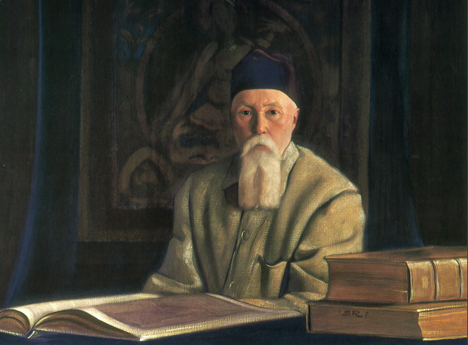Nicholas Roerich: A Quest and a Legacy

A painting of Nicholas Roerich by his son Svetoslav
Nicholas Roerich was a scholar and practitioner of many disciplines. He pursued art, literature, and spirituality. He was a seeker of knowledge, a guardian of culture, and a purveyor of peace. He has left an oeuvre so vast and varied that a holistic understanding of this heritage requires extensive analysis from multiple perspectives.
“Since Nicholas Roerich continues to arouse the interest of extensive scholarship and the question often asked is: what is the draw and pull of a man who was, in his final avatar, a painter of mountains?” – book jacket description
An anthology of articles ‘Nicholas Roerich: A Quest and a Legacy’ serves this very purpose. This volume of 22 essays by internationally reputed scholars has been edited by eminent writer and art historian Manju Kak. The commentary on Roerich’s legacy is supplemented by rare archival photos and reproductions of paintings from the archives of the Nicholas Roerich Museum, New York, the International Centre of the Roerichs, Moscow, the International Roerich Memorial Trust, Naggar Kullu and from the State Russian Museum, St Petersburg.
“The book describes his quest for Russia’s roots, art, involvement with theatre, expeditions, understanding of Shambhala, and works as a peace activist and theosophist,” Kak says. She effectively strings together varied accounts of Roerich’s personality and his quests. It helps that she is herself a trained artist, an interdisciplinary scholar, and shares an affinity to Himalayan ethnography with the great Russian visionary.
Roerich’s oeuvre is ‘beyond art,’ that is not a value but a dimension or space, easier understood by Indians where everyday lives are indoctrinated by spiritual lacings
The book has contributions from historians, curators, disciples, members of Roerich societies, and Buddhist scholars. They speak with the authority and objectivity of subject matter experts as they trace Roerich’s life and work. Suchandana Chatterjee, an expert on Inner Asia, slots him with 19th &
Roerich’s travels honed his vision and resulted in over 7000 paintings and about 30 literary works. Madhavan Palat, a scholar of 19th and
“What I admire the most in Roerich’s paintings is the fact that he has not allowed culled knowledge to interfere with what he sees in the Himalayas. It is as if the viewer is looking through a prism. The artist becomes the prism. He doesn’t interpret the mountains for you but presents them as he sees them.” Kak describes the artist’s uncluttered perception of beauty.
The Christie’s auction of one of the `Legend’ series at $1.6 million was a benchmark in 2009. Recently `Portrait of Nicholas Roerich in a Tibetan Robe’ by his son Svetoslav created another record auction of $2,994,500.
Roerich
Roerich’s works were steeped in spirituality. Buddhist scholars like Tashi Paljor, Andrea
The most influential of Roerich’s legacy is his contribution towards global peace. ‘The Roerich Pact’ was the first international treaty for
Roerich’s teachings of Living Ethics are the subject for Marina Bernardi. She is a practitioner of Agni Yoga and in-charge of the
A man only discovers Beauty through Culture, an inseparable part of which is Creativity
The collection of scholarly writings also includes a firsthand account by Sina Fosdick who was one of the Roerichs’ closest colleagues and a participant in Altai and Mongolia parts of the Central Asian expedition.
The volume provides a thorough and credible appreciation of all aspects of Roerich’s quest and legacy. In the context of the increased worldwide interest in this multifaceted man and the complex nature of contemporary
All rights reserved by Rossiyskaya Gazeta.
Subscribe
to our newsletter!
Get the week's best stories straight to your inbox